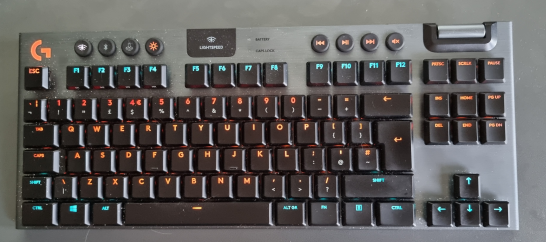I have always been tempted to get a TKL keyboard, but somehow never had the impulse to do so.
Some time ago, however, one of my old, worn-out keyboards went into premature retirement to the dustbin and I decided to give TKL a chance.
After wandering through countless pages of the internet and watching even more countless review slash guides I decided on Logitech's G915 TKL. Partly because I liked it visually, partly because I like the company (especially products connected by Lightspeed, which - unlike Bluetooth - operates with a latency several orders of magnitude below human perception), but let's not fool ourselves, mainly for the volume knob.

The knob is wide, smooth-running and, best of all, has almost zero inertia (you have to push it really hard to notice any). All this makes it the most convenient way to set the desired volume in a minimum time without taking your eyes off the screen.
TKL stands for "Ten Key Less" meaning no numpad. At first, I was a little afraid of the lack of an additional island with digits, but it turned out that quite unnecessarily. Maybe if I were an accountant, or I do not know, some kind of numerician; as a programmer slash Datarat, it does not bother me at all. And thanks to it, I now have more space on my desk to fit an extra cuppa, or I don't know, slide my mouse 🙂
The keyboard also has the advantage of being able to connect to two devices at once, and if you try well, even to three. One via Lightspeed, another one via Bluetooth and the third… via a USB charging port. As it turns out, connecting the keyboard with a USB cable to the laptop not only charges the battery but also disables the Lightspeed and Bluetooth, and activates the communication via cable instead.
When it comes to ergonomics - it's phenomenal. Unlike modern laptop keyboards, which are pratically flat, here the keys have quite a high (and clear) travel, and in addition the distance between the caps is a small fraction of a millimeter smaller than in a standard keyboard, which makes it easier to reach the keys at the edge, and then - type faster. Or at least so I think.
Each key is illuminated individually, with a palette of a bazzillion colours, so if you are really bored, you can make it into a completely crazy fireworks display, which is however a bit tiring on the eyes in the long run. I set it to orange letters and a kind of azure control keys. As a result, it looks like this:

It has two pretty long fold-out legs and three rubber pads underneath, so it remains in one place and allows for comfortable, prolonged typing.
There are no additional "gaming" keys, which annoy me a lot, especially if they are placed on the left edge and every now and then instead of pressing Ctrl I press G1 or some other S*.
There are eight additional keys on the top: the four on the left are clearly useless unless you switch between BT and LS (which I don't), or set the brightness to 25% right after unpacking, to maximise battery life, while the ones on the right are useful occasionally - mainly to control Spotify.
The battery, with the backlight set to 25% and with usage between 8 and 10 hours a day, lasts for more than five days on a single charge. This may not be comparable to G613, where I failed to drain the battery in over fourteen months of heavy use, but it's still pretty darn good.
I've been using this keyboard for well over a month now and am absolutely delighted. A solid 10/10.
Highly recommended.
Jeżeli chcesz do komentarza wstawić kod, użyj składni:
[code]
tutaj wstaw swój kod
[/code]
Jeżeli zrobisz literówkę lub zmienisz zdanie, możesz edytować komentarz po jego zatwierdzeniu.